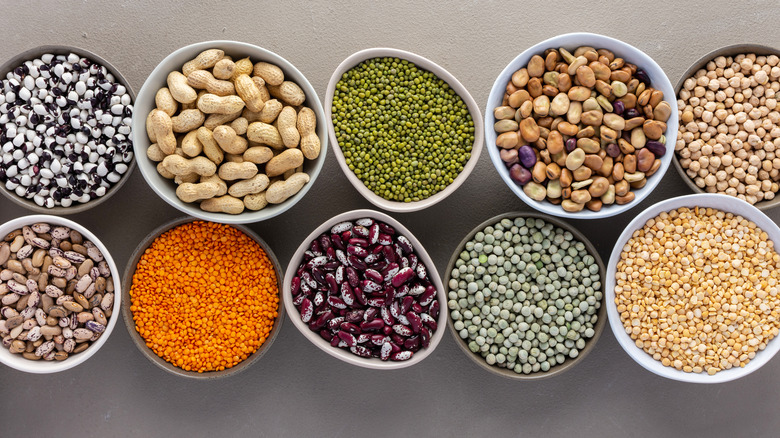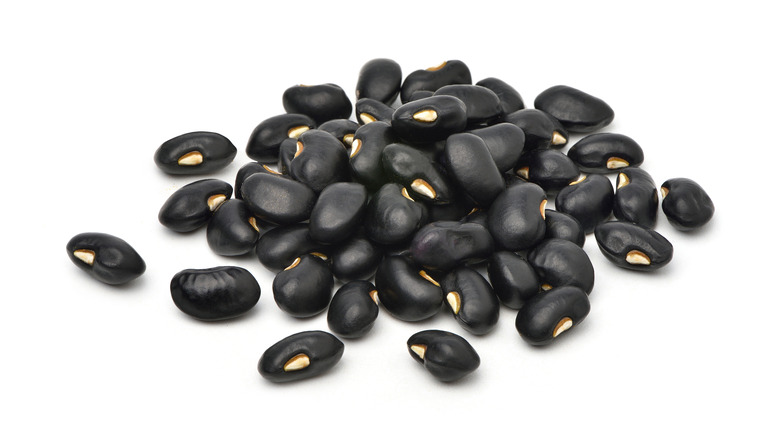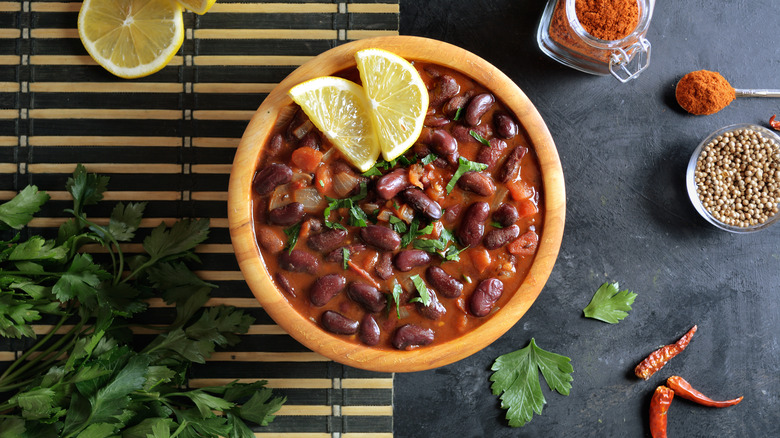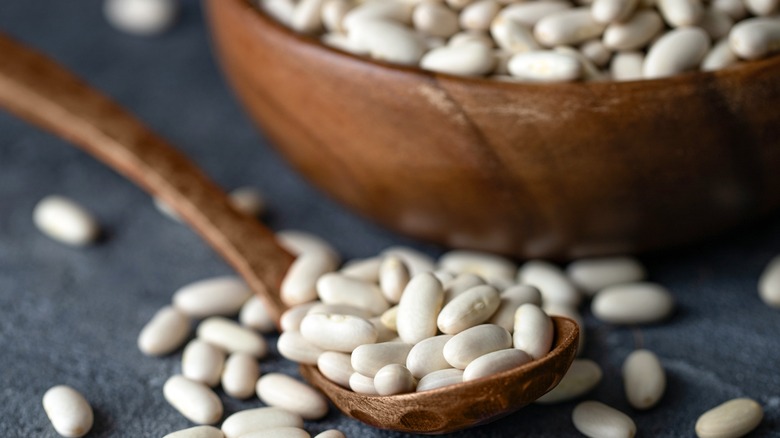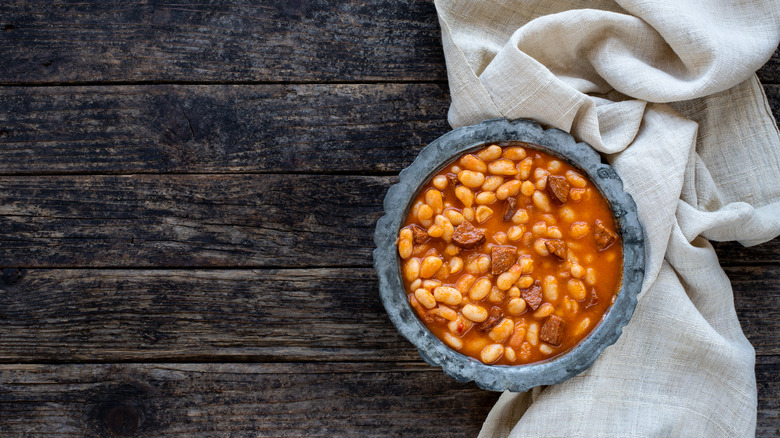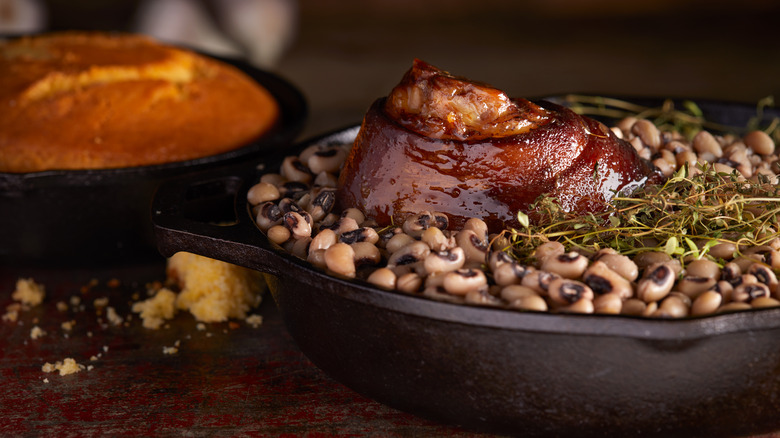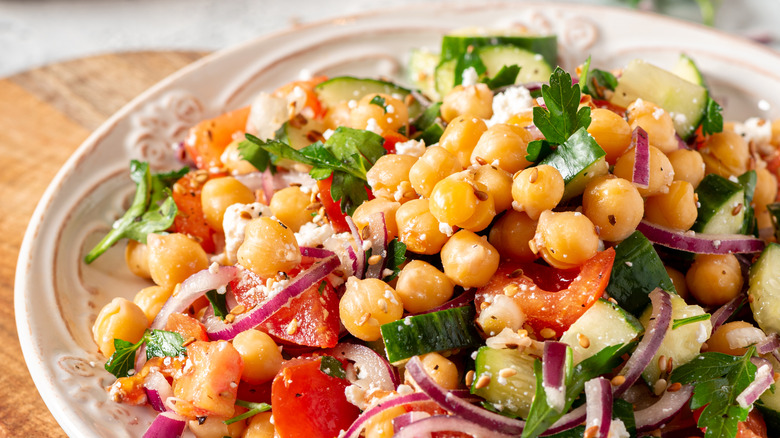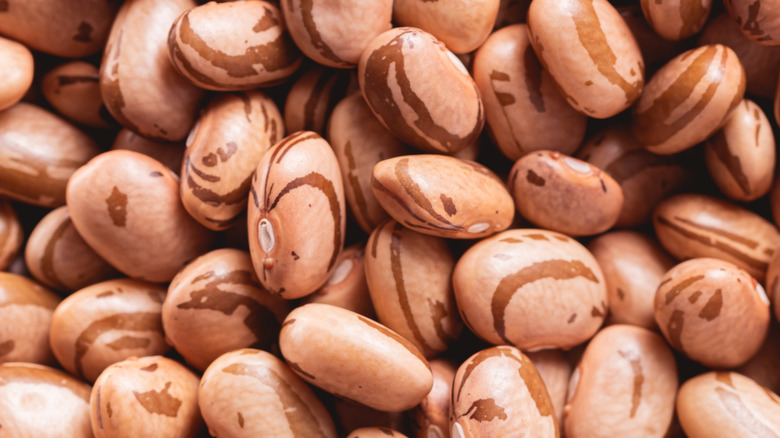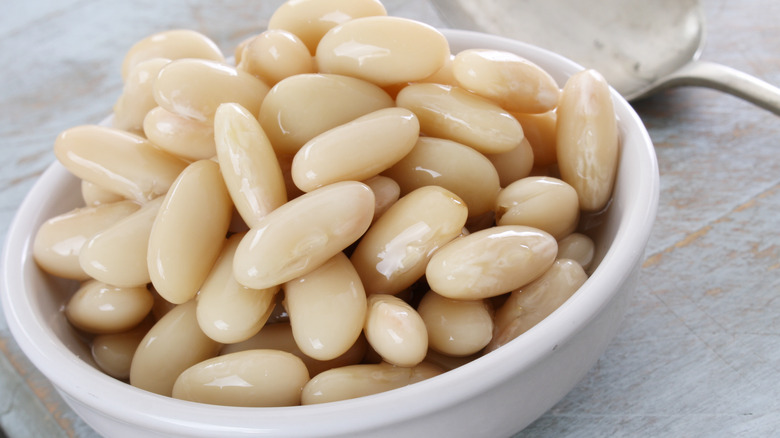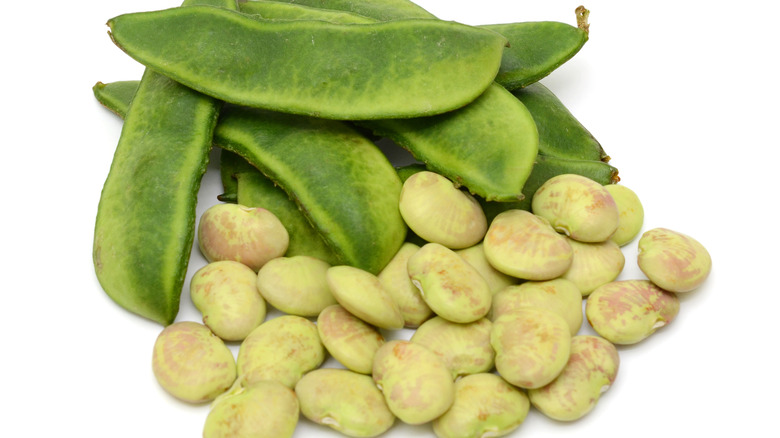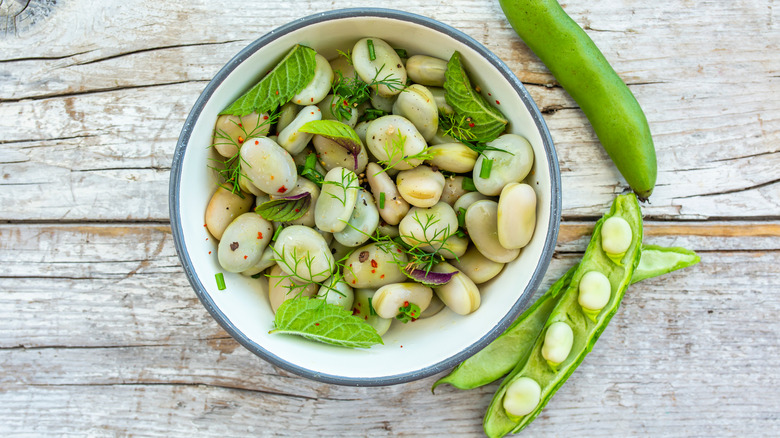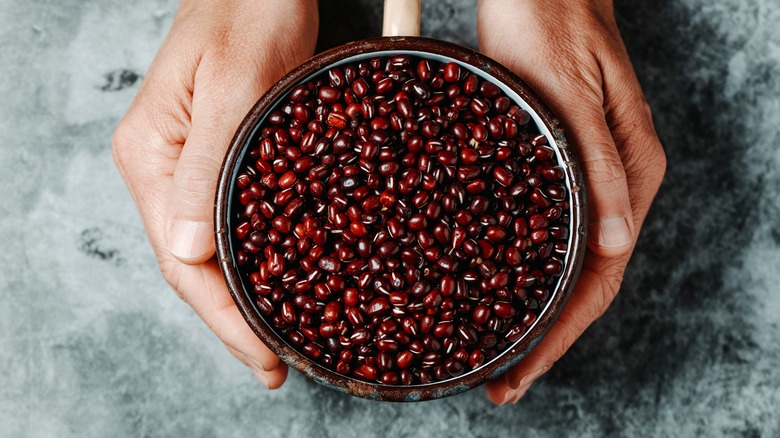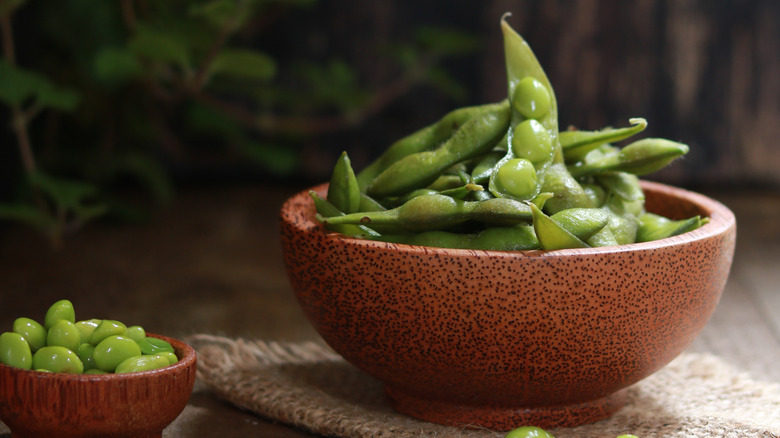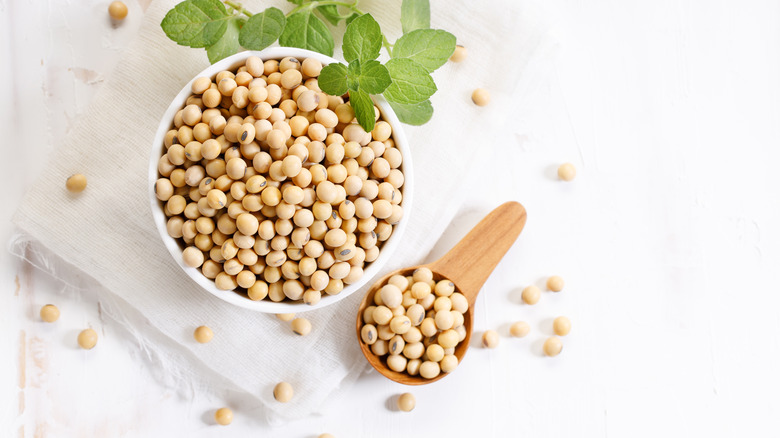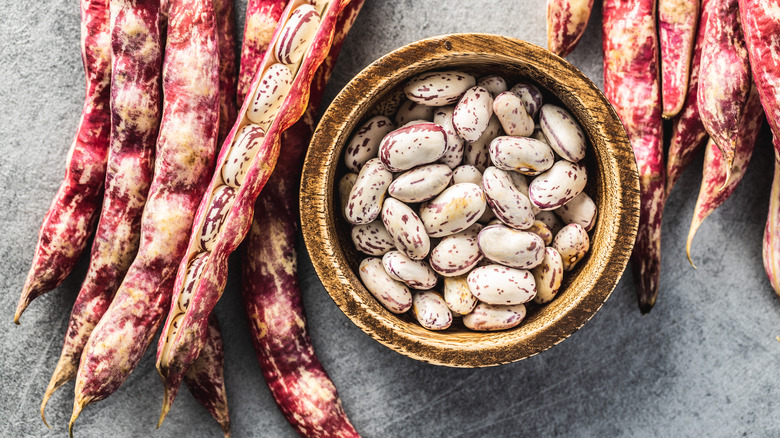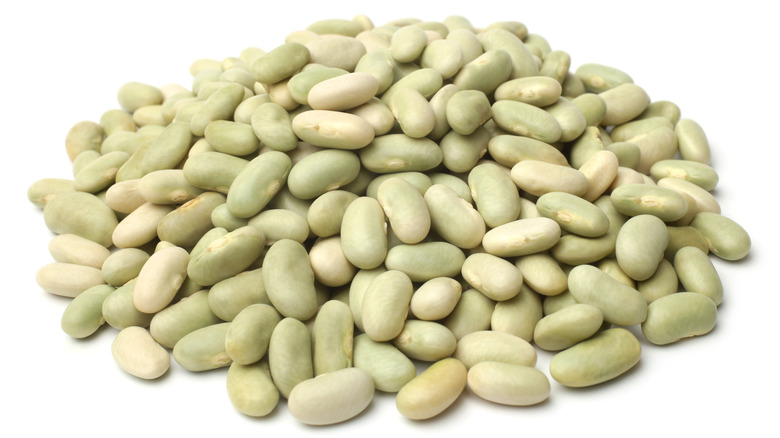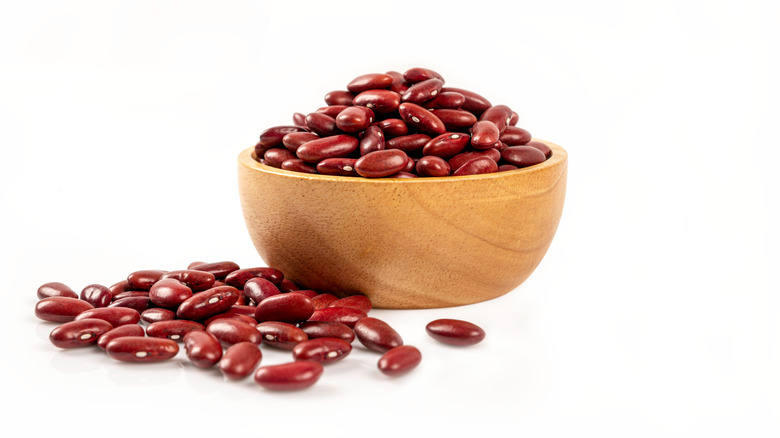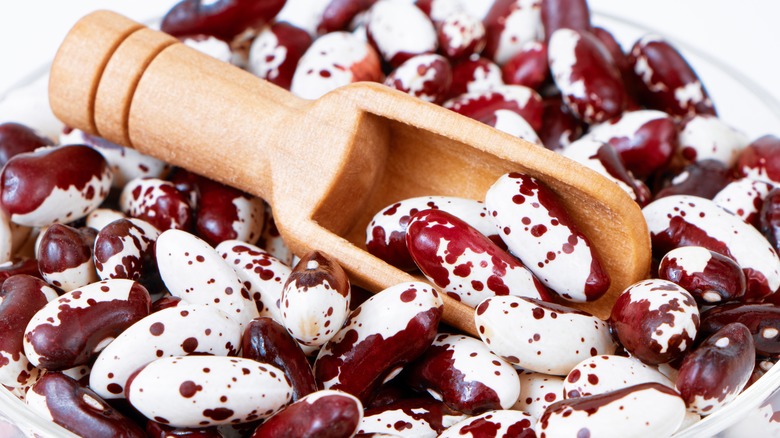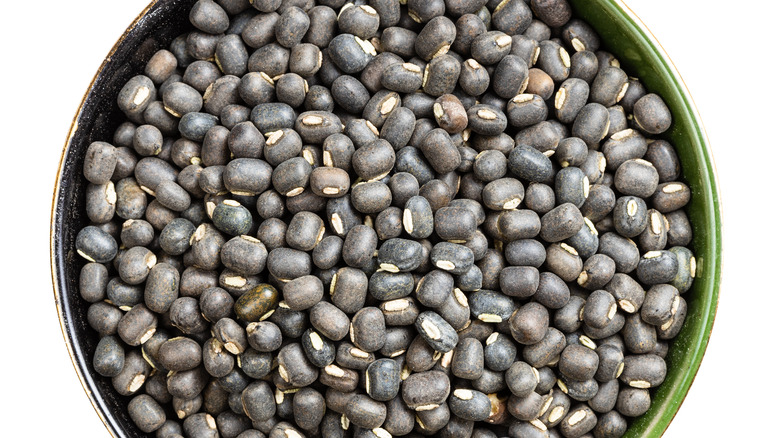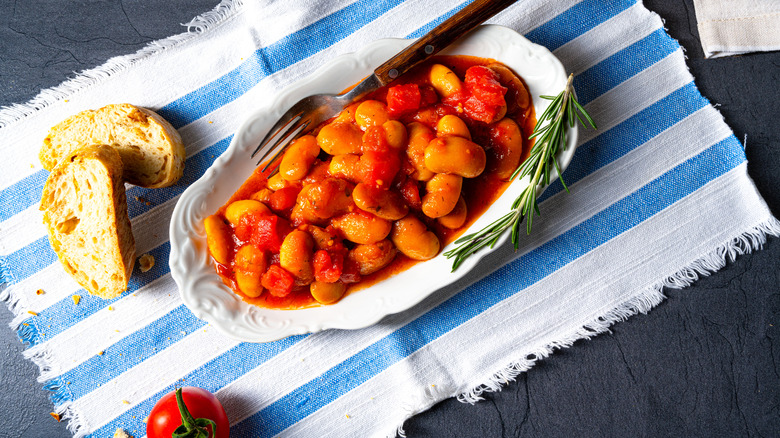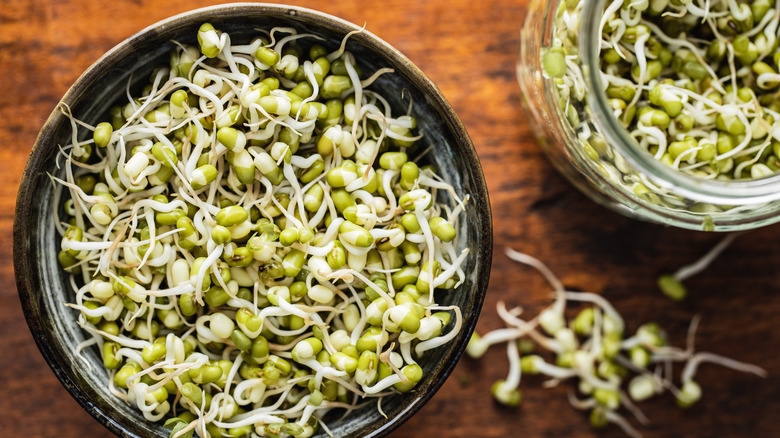20 Most Popular Types Of Beans Explained
At the pandemic's beginning, many of us stockpiled canned and dried beans due to their long shelf-life, affordability, and nutritional value. According to Medical News Today, they are a great source of protein, fiber, iron, and vitamins that offer many nutrition benefits. Beans are rich in amino acid protein, and our bodies need that to heal and make new tissue — such as bone, muscle, hair, skin, and blood. Beans are a food class we should be using more in our daily lives.
The Bean Institute (yes, there's a bean institute) stresses the necessity for a more bean-friendly diet. The U.S. Dietary Guidelines for Americans recommends eating about 3 cups of legumes, including beans, per week. Accordingly, USDA MyPlate guidelines count beans as both a vegetable and a plant-based protein source, so you'll be saving two birds with one bowl. A half-cup of beans a day will get you to the recommended amount of legumes.
Beans play an important role in a vegetarian diet, but everyone can benefit from the nutrients they offer. Bean me up, Scotty! Beyond wellness and reasonable price point — beans are a delicious staple and are extremely versatile. They are also a trip around the world through your kitchen, as different beans are grown all around the globe and employed in so many scrumptious ways. One word of advice — cook your beans — most beans have slight toxicity before they are prepared, though canned beans are usually already cooked.
Black Beans
Black beans play a prominent role in Latin American cuisine and are very important to Cajun and Creole dishes from Louisiana, as well as Tex-Mex plates. From frijoles negros (Cuban black beans served over rice), Southwest chicken and beans, and black bean soup to Creole black beans and sausage, these soft and mildly flavored beans are as adaptable as delicious. Did you know you can swap out black beans in place of flour? Check out this recipe for black bean brownies.
Web MD states that incorporating black beans into your diet could help control weight, prevent cancer, and keep your eyes and heart-healthy. Black beans are a powerhouse of antioxidants, fiber, protein, and good carbohydrates, which aid in the prevention of certain medical conditions and assist the body in caloric processing. According to Foods Guy, make sure you don't overcook them, as they will lose some of their nutritional potency.
Kidney Beans
Shaped like a kidney, these red, curved beans with a white inside may aid in kidney health, per LiveStrong. They contain an abundance of vitamins and minerals and are lauded for being high in protein — 18 grams in 4 ounces, to be exact. This makes kidney beans a popular choice among vegetarians, inviting Healthline and others to call it the "poor man's meat."
Easy to find and a common ingredient in many dishes, kidney beans can seamlessly fit into your regular meal rotation. Their gentle flavor adds texture and depth to chili, tacos, wraps, and more — but don't sleep on more adventurous kidney bean recipes. The variety of tastes that kidney beans fit with is unmatched, from Creamy Kidney Bean Salad to Chicken and Kidney Bean Persian Stew and Cowboy Caviar. Be forewarned; Foods Guy suggests using a stovetop pot versus a slow cooker for cooking these beans. Kidney beans contain a protein called phytohemagglutinin, which is toxic and could survive in the small crevices of a slow cooker. They also suggest cooking for an extended period so that the beans absorb more flavor. However, if they begin to lose their kidney shape, you've gone too far.
Great Northern Bean
It's a little more elusive than other beans on our list but well worth the search; great northern beans are white beans that are often mistaken for cannellini or navy beans (and can be used to swap for them in recipes). Very Well Fit says that because great northern beans hold their structure so well, they can often fill out sustaining soups and stews. Despite the hardy usage, they have a delicate, nutty flavor and their medium to firm texture makes it easy for seasonings to infuse into the beans. Cook's Info reports that the texture of cooked great northern bean is soft enough to be used in a mash.
Great northerners are ideal for casseroles because they are great binders and will significantly soften with enough cooking. This is also why Randall Bean Company suggests using them to make eggless and flourless desserts. Savory meals, like our Slow Cooker Chicken Ribollita recipe, call for the beans to grant a substantial body to your next weeknight dinner. Nutritionally, great northern beans are very high in calcium ... maybe a great northern bean milk alternative is in our future? In the meantime, we'll get them through cassoulet or Boston baked.
Navy Beans
Did you know that navy beans got their name from the U.S. Navy? Also called Boston beans, Yankee beans, haricots, or pea beans, they have been an important part of the United States military culture for over 200 years, per Masterclass. The traditional soup served to our sailors can be replicated with help from the Naval History and Heritage Command. Navy beans have high fiber content, making them perfect for filling up a large group of hungry seafaring officers. Similarly, they are used as a breakfast staple due to their ability to break your fast and prepare you for the day.
Navy beans are a component of a traditional English breakfast, alongside fried eggs, sausages, back bacon, tomatoes, mushrooms, fried bread, and white or black pudding. Home cooks can incorporate these small, mild-flavored white beans into any meal of the day. Try them in minestrone, Turkish white bean salad, or classic navy bean and ham soup. Navy beans cook between 45 and 90 minutes, depending on if you've soaked them, and have 7.5 grams of protein in a half-cup serving (via Very Well Fit).
Black Eyed Peas
Happy New Year! Black-eyed peas have been a New Year's Eve tradition for generations because of the superstition that they will usher in a lucky year (via Modern Farmer). As it goes, our modern reverence for this cowpea bean goes back to the Civil War, when it was considered lucky to have survived field fires lit by the Union Army. Garden & Gun points out that history shows a correlation between black-eyed peas and good luck in early and current West African cultures. These beans are served on special occasions, as West Africans have long regarded them as a "good luck charm that warded off the Evil Eye."
When the tradition came to the South, it was initially in a dish called Hoppin' John, in which rice is cooked along with black-eyed peas. Whether you believe the superstition or not, these small white beans with a black, pupil-like dot in the middle can certainly bring fortune to you in the form of sustaining nutrition. Consumer Reports state that black-eyed peas are a one-stop shop for protein, fiber, magnesium, and zinc.
Chickpeas
There are so many things you can do with chickpeas beyond hummus. Also known as garbanzo beans, chickpeas are a staple in Middle Eastern cuisine. From stews, soups, dips, and salads, chickpeas are eaten in abundance. Like so many other beans, chickpeas offer a plethora of health benefits. Healthline states that, in addition to being chock full of nutrients, chickpeas are high in protein and fiber, which may keep you feeling full and reduce your calorie intake at meals. They may even prevent cancer and aid in raising iron levels.
Canned chickpeas are easier to use. However, Health Digest tells us that despite the matching potassium levels of canned and dried chickpeas, this legume loses some important vitamin and mineral content while gaining over 100 milligrams of sodium when canned. The simplest way to lower sodium levels is to rinse your canned chickpeas, as dried chickpeas require a long soak and a fairly extensive boiling period (via Food52).
The nutty and rich taste of chickpea is an asset in many dishes. They are the star in hummus, but branch out and try Moroccan Chickpea Salad or Pasta e Ceci (pasta with chickpeas). And just like black beans, chickpeas can be used as a sneaky substitute for flour in many desserts. Bob's Red Mill writes that chickpea flour adds subtle fullness to baked goods.
Pinto Beans
If you've ever had refried beans, then you have had pinto beans. But, you may not have seen them before they were cooked. Per Camellia Brands, the word pinto means "painted" in Spanish. Indigenous to Mexico and Peru, these beans get their name due to the way their creamy shell looks as if someone took a paintbrush with mahogany stain to them. Although smaller than many other beans, pintos are powerful.
Throw your vitamins away, says New Mexico State University. Pinto beans are packed with protein, fiber, micronutrients, antioxidants, iron, potassium, magnesium, calcium, phosphorus, and B vitamins folate, thiamin, riboflavin, and niacin. Additionally, El Pollo Norteno tells us that they contain the flavonoid kaempferol, which is known to reduce inflammation and lower the chances of a stroke. Their earthy flavor beckons to be used in both haute cuisine and simple dishes alike, and Camellia notes them as one of the "common beans" because of it.
Cannellini Beans
Also known as white Italian kidney beans, cannellini beans are distinctly popular in Meditteranean cuisine (via Very Well Fit). Their mild flavor and silky texture make them easy to utilize in several ways. Sources suggest adding texture to a green salad, simmered with spices, or simply mashed into a lazy hummus for wraps and sandwiches. Cannellini beans retain their shape very well, making them ideal for recipes like White Chicken Chili. And, maybe we are stating the obvious at this point — they're good for you.
Very Well Fit says that cannellini beans might be the ideal ingredient for macro counters due to many aspects. The beans offer plenty of fiber and protein (5 to 8 grams per half-cup) but remain lower in calories. They also contain nutrients such as calcium and iron. It's important to know too that cannellini beans are often processed with large quantities of sodium, so be prepared when shopping for the canned variety. Dried cannellini beans cook for 60 to 90 minutes and store in the fridge for several days.
Lima Beans
Sufferin' succotash. Lima beans got a bad rap growing up — thought of as the food of punishment — and even now, their suggestion may trigger memories of being stuck at the dinner table for endless hours, fighting down the last bite. Maybe we hated them because of their green hue. Speaking for ourselves, we think this was misguided because limas are delicious. And as it turns out, there is a reason your parents wanted you to finish your beans.
Healthline claims that lima beans are linked to healthy weight loss, enhanced blood sugar control, and improved heart health. What's more, they're good for your tastebuds and your body. Lima beans have a creamy texture and delicate flavor and can be used in various ways. Succotash (lima beans and sweet corn) is one of the most well-known but check out some more far-reaching recipes such as this chilled butter bean soup with peanut-corn relish. You can find lima beans in cans, dried, or frozen.
Fava Beans
Fava beans and a nice Chianti ... hold the liver. Despite the unnerving Hannibal Lector line in Silence of the Lambs, fava beans are a wonderful component of many meals. According to Masterclass, favas are also called broad beans, though their usage when fresh can be restricted as they are difficult to work with. Not to evoke another Silence of the Lambs reference, but to eat fava beans, you have to take their skin off. To reach this stage, you must first peel fava beans from their pods and blanch them. For dried favas, MasterClass calls for an overnight soak of 10 cups of water for every pound of beans! Fortunately, canned fava beans are accessible and an easy way to have the work done for you.
Sources share that fava beans are one of the world's oldest cultivated crops, citing the beans as important foodstuff for Classical Greeks, Romans, and Egyptians. These beans are sweet and nutty in flavor with a buttery texture. Try them in a recipe of multinational flavors, like these fava beans with burrata, toasted almonds, and nigella seeds.
Adzuki Beans
If you've ever had Anko, or red bean paste, which commonly fills the form of Japanese desserts such as mochi, you have had adzuki beans (Via Savor Japan). Hailing from Asia, these beans are naturally sweet and boast a starchy texture, which, as well as being perfect for use in desserts, can aid digestion (via Healthline). And what a great way to incorporate a healthy ingredient into a sweet treat. Research also suggests that good bacteria from this bean can be beneficial to gut health.
Adzuki beans may help with weight loss, provide anti-aging properties, and prevent cell damage, per WebMD. Of course, beyond the sugary focus, adzukis can be used in many savory recipes as well. For example, there are plenty of hearty meals using adzuki Beans, including one dish that pairs them with pearled barley and kale, or a Red Dragon Pie, which is a pretty neat vegan-take on shepherd's pie.
Edamame Beans
You can't sit down for a sushi meal without first enjoying some delicious steamed edamame. They also make for a fun starter for kids — you can't beat being allowed to play with your food! How enjoyable is it to clamp your teeth at the top of the pod and pull it through your chompers releasing the bright green edamame kernels with a pop!? The sensation is almost as strong as you'll be after eating these beans: a single serving holds 33% of your daily protein and around 20% of daily iron. Along with being a fresh snack edamame is also great as a base for hummus, on top of a grain salad or a soba bowl, or even as the main ingredient in an edamame soup with smoky mushrooms.
Medical News Today writes that edamame is young soybean, and according to information from the site, soy can have success in lowering the risk of cancer and osteoporosis due to the isoflavones it contains. Further nutritional values point out that one cup of hulled edamame beans provides an adult with almost 10% of their daily calcium, more than 10% of their daily vitamin C, and at least 34% of their daily vitamin K, at least 120% of their daily folate.
Soy Beans
As cited in Medical News Today, soy contains isoflavones, which are compounds lauded for lowering the risk of cancer and osteoporosis. Specific research even suggests a strong link between high-soy diets and reduced risk of breast cancer in some populations. And, did you know that soybeans contain hormone-like substances (called phytoestrogens), which copy the action of the female hormone estrogen? It is thought that soy can reduce menopausal symptoms (such as hot flashes) — per Better Health. This can explain why many common menopausal supplements are made from soybeans (via the University of Rochester).
Another benefit to soybeans is that there are more delicious, inventive ways to incorporate them into your diet. Unlike other beans, soy can be found in many plant-based meat substitutes. However, you don't need to be a vegetarian to fall in love with tofu or tempeh-based meals. With flavors like in this instant pot tofu with shiitakes, kale, and miso-ginger broth, soybean will become a regular on the dinner circuit. It is good that these options exist, as LiveStrong reports that, unlike edamame, mature soybeans cannot be eaten raw.
Cranberry Beans
Cranberry beans don't taste like cranberries but rather get their name from their gorgeously pink-speckled shell. Unfortunately, they lose their color when cooked. Cranberry beans have an intriguing, nutty flavor and are commonly used in Italian soups and stews. Clean Eating explains that cranberry is a native bean of Colombia containing all nine essential amino acids. Bean lovers can find the richest flavored beans by seeking out plump pods with a similar dark pink and tan speckle as the beans inside. These will taste slightly herbaceous and fully smooth.
This cranberry bean soup recipe showcases your new favorite produce in a garlic-and-chorizo-infused broth with Brussels sprout leaves. Or maybe you want to get multicultural by making an Italian and Japanese mash-up, ala Tuscan-style beans with bacon and kombu? Either way, cranberry beans are a great way to expand your bean palate. When purchased fresh, they keep in your refrigerator for up to four days. For a simple unshelling, take them out to dry a day or two before using.
Fayot Beans
Much like edamame beans which are the immature version of soybeans, fayot (or flageolet beans) are regarded as a young kidney bean (via Specialty Produce). These tiny, mint-green colored beans pack a mild, clean taste and a velvety texture that lends easily to the French cuisine where they are so often found (via What's Cooking America). Some outlets, such as Masterclass, even call them the "caviar of beans." Hailing from France, flageolet beans can be difficult to procure, but What's Cooking America states that California is one place in the country where they are currently cultivated.
Flageolet beans are luxurious because they can mostly be eaten raw, requiring very little cooking at all. Nutrition and You describes the many health attributes of eating flageolet beans — high vitamin and mineral content, rich in fiber and protein, low-fat and cholesterol-free. They may even ward off cancer-causing chemicals in the colon as their high levels of dietary fiber bind to toxins and flush them out of the gut. Oh là là!
Red Beans
There tends to be some confusion between red beans and kidney beans, but Lacadamie helped us differentiate. First found in Peru and the Caribbean, red beans are commonly used in Central America, Creole, and Southern cuisine. There are the previously mentioned adzuki beans and another variety called Mexican small red beans.
Red beans are an important piece of certain cultures. There is a Red Bean Parade in New Orleans, where parade-goers celebrate these tasty beans by marching through the city wearing special outfits and following the "Bean Mobile," a car completely covered in red beans. Red beans are a traditional Monday meal, and Louisiana Travel theorizes that this is because of two reasons. There was usually a leftover ham bone from Sunday dinner that was perfect for adding flavor to a pot of simmering red beans, and Mondays were typically considered wash day, so a dinner that could cook slowly over multiple hours was ideal.
New Orleans Red Beans and Rice is a classic example of how they are utilized in Creole cuisine, while in Peru, Tacu Tacu is all the rage. On their own, red beans are mild, nutty, and slightly sweet. Nutritionally, they boast many of the same qualities as other beans, such as being a good source of protein, fiber, vitamins, and minerals (via Camellia Brand).
Anasazi Beans
Anasazi beans are heirloom beans that have an intriguing, bold cow print. The name comes from the Navajo word for "the ancient ones," per Cook's Info, though it is now a trademarked bean product of Adobe Mills. It is said that Native Americans who lived in Colorado, New Mexico, Utah, and Arizona around 500 AD integrated this foodstuff into their diet in various ways. They are considered an heirloom variety, and theories abound about how their cultivation has been maintained for centuries. Today, the meaty texture of Anasazi beans makes them perfect for baked dishes, such as Tex-Mex baked beans topped with cornbread.
Healthier Steps lays out all the nutritional facts, stating the generally high protein, fiber, and nutrient content that most beans contain, but adding an interesting point that sets these beans apart; Anasazi beans are high in lectin content. Lectin is a type of plant-based protein known for its strength as a potent antibacterial, anti-tumor, anti-fungal, and immunomodulatory agent. Such a healthy food can go well beyond baked beans in terms of flavor. This umami Anasazi bean recipe is a sultry vegan dish formed from an eternal truth — Anasazi beans cook down very fast.
Urad Beans
Urad beans are sometimes called black lentils, black gram, Vigna mungo, or several other names. It is a small black bean from South Asia that is seen a lot in Indian dishes from dal to dosa batter and is considered one of the best proteins on the planet, per Science Direct. Research shows that urad beans hold a higher protein value than most legumes. Reports also reveal urad to be an excellent source of dietary fiber, isoflavones, vitamin B complex, iron, copper, calcium, magnesium, zinc, potassium, and phosphorus. With a myriad of potentially healing health benefits, its medical properties are used in oils for your skin and other Ayurvedic approaches.
Clove Garden writes that crushed urad beans are also used as an ingredient in spice mixes. Dosa is a thin, wrap-like bread of Indian origin that is often stuffed with spicy potatoes and vegetables and made from a batter of Vigna mungo. A classic masala dosa recipe packs many of the nutritional benefits of this bean into a spongey crepe-style dish. For the purest form of urad beans, we suggest dal, a soft and textured stewing preparation.
Gigante Beans
As you may have guessed, these beans are gigantic. Gigante means gigantic in Greek (which is where these beanstalks sprout). The meat of these beans has a super creamy inside, and My Greek Dish illuminates how they become tender when cooked in tomato sauce and can easily soak up all the yummy herbs and spices added when making traditional plates like Gigantes plaki. Accordingly, these beans are as filling as they look. One cup of cooked Gigante beans holds 15 grams of protein, 209 calories, and 12 grams of dietary fiber (per NutritionIX).
Plaki, a traditional Greek dish, is a rich, (potentially) vegan dish served with crusty bread that makes it a simple and healthy comfort food go-to. Per Food52, these large white beans might be difficult to find, but worth the search! You'll have better luck finding them in your local specialty Greek markets. Due to their large size, extra soaking time is necessary if making them from dried form. If you are short on time, throw them in the instant pot for quick cooking.
Mung Beans
Mung Beans are quite similar to adzuki beans in flavor and texture and can be used interchangeably. Vegfaqs points out that the bean sprouts you buy in the grocery stores are almost always made from mung beans. Sources go on to say that mung beans have a particular taste that arrives in earthy, lightly sweet, and nutty notes when cooked. Mung beans need abundant sunlight to grow and abound across Asian cuisines, where they're especially present in desserts. Other methods of use are simply to sprinkle the sprouts on a sandwich or salad or to use them in something savory, like a healthy Moong Dal recipe.
Interestingly, as Healthline writes, in many Asian countries, mung bean soup is commonly consumed on hot summer days. Evidently, mung beans contain certain antioxidants called vitexin and isovitexin that may protect against heatstroke and resist damage from free radicals. Mung beans have also been linked to reducing "bad" LDL cholesterol.
